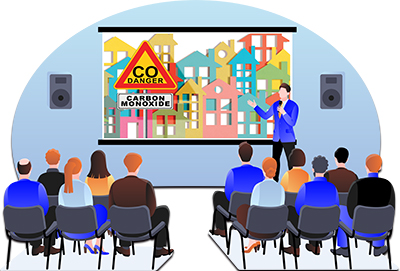November is National Carbon Monoxide Awareness Month. Many organizations including the National Carbon Monoxide Awareness Association (NCOAA), and National Comfort Institute (NCI), have been working tirelessly for years to increase public and industry awareness about this silent killer.
Equally important, for three decades NCI has brought attention to the severe health issues that stem from low-level CO poisoning. NCOAA has also driven this message since it started in 2015.
According to reported statistics, CO poisoning is responsible for more than a thousand recorded deaths and more than 100,000 emergency room visits. When you add in unreported cases, the real numbers are significantly higher!

BECOME A PRE-RESPONDER
In October’s One More Thing column I wrote about the NCI-coined term, “Pre-Responder” to describe how HVAC professionals can be a primary deterrent to CO poisonings.
While emergency “First Responders” also need better training and tools to deal with CO poisonings, by the time they get there it’s often too late. Significant damage, permanent health issues, and even death may have already occurred.
You become a Pre-Responder by adopting a proactive approach to evaluate whether mechanical systems are either causing, or have the potential to cause CO to be generated and/or released into the homes and buildings you service.
Carbon Monoxide is colorless, odorless, and tasteless, and it can strike in any building where combustion appliances operate.
To detect existing CO issues, and help prevent potential CO incidents your technicians, installers — even your salespeople — need the training to keep both themselves and your customers safe.
GET THE RIGHT TOOLS AND TRAINING
While equipping your field people with combustion analyzers is a good first step, it’s not enough. Your employees’ safety starts with wearing personal CO monitors to help ensure they are not exposed when they enter a home or building.
There are specific protocols that should be followed starting with before you enter a building, throughout the process of testing the conditioned space, and the combustion appliances within it.
National Comfort Institute has been training and certifying professionals on these processes for nearly 30 years. They have a deep understanding of the causes of CO, from building pressure imbalances, to improper combustion air, venting, and equipment installation, and so much more.
A CALL TO ACTION THIS NOVEMBER
During National Carbon Monoxide Awareness Month, let’s turn awareness into action. Plan and execute the following steps this fall, winter and year-round:
- Review and update your company’s CO safety protocols
- Ensure all of your field personnel have a personal CO monitor and a calibrated combustion analyzer
- Make sure all of your techs and installers are trained and certified in Combustion Safety and Diagnostics.
- Discuss with your customers the differences between CO monitors and detectors. Explain the importance of regular maintenance and testing.
This November, start making CO safety and ongoing training part of your company’s DNA.
The lives you save could belong to your customers — or your own employees. Become a Pre-Responder today!













Recent Comments